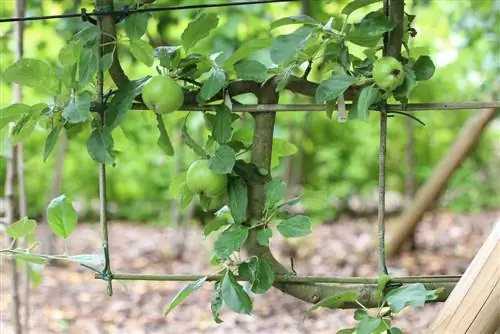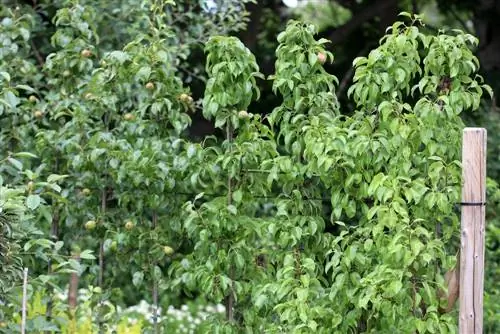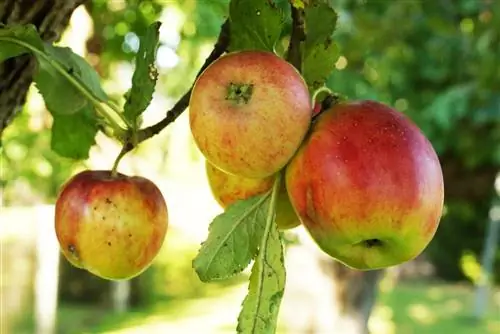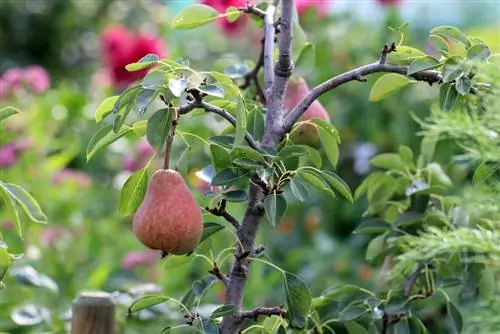- Author admin [email protected].
- Public 2023-12-17 03:39.
- Last modified 2025-01-24 12:45.
If a fruit tree needs to be grafted, it is usually because it needs to be propagated. This is not always possible through seeds or cuttings, which is why grafting is a particularly popular option in garden centers and tree nurseries.
Refinements are also carried out to increase the yield of fruit trees, and in ornamental plants this increases the willingness to flower. Some plants can only thrive in unfavorable soil conditions through grafting.
Fruit tree grafting with scions
If fruit trees are to be grafted, there are a few steps to follow carefully. Of course, only a tree is selected whose benefits and advantages are known. First, a so-called scion must be cut. This is taken from the crown in the upper or southern part. It should be about the thickness of a pencil and already have well-developed eyes. Of course travelers have to be he althy. A middle part with three to four eyes is used.
Tip:
Do not cut rice in winter below -4 °C.
You don't have to meet any surgical requirements, but the interfaces should not be touched with your fingers. Scions can also be cut in summer, but then they must not be exposed to the sun so as not to wither prematurely. The purpose of scions is to transfer the benefits of the mother plant to the new plant. This is good fertility in most cases. After cutting, the wound surfaces are closed with wound wax, leaving only the bottom eye free so that it can sprout. The rail is connected with bast from top to bottom and thereby pressed against the base.
After a few weeks, this binding material is cut vertically with a sharp knife. The right time can be recognized by the fact that it begins to constrict. However, it is not completely removed but remains on the tree. As soon as small shoots appear from the buds, the grafting can be described as successful.
Fruit tree grafting through copulation
During copulation, the scion is connected to a base of the same thickness; it should be about the thickness of a finger. An oblique cut about 3 to 4 cm long is made on both parts so that the bark fits on the bark. The cutting surface should be at least three times the length of the diameter of the scion. In addition, both parts must show an eye towards the cut surface. With this refinement, the scion must be cut shortly beforehand and should come from the same year. The leaf stalks of the scion remain intact and dry out after a few weeks. This is also a sign that the refinement has been successful. Afterwards, side shoots and leaves from the rootstock should be removed.
The procedure is similar for copulation with so-called opposite tongues. The cut is made 1 cm deep in the direction of the longitudinal axis and is made at an angle. This creates toothing that stands against each other and is pushed into one another.
Fruit tree grafting through inoculation
When inoculating fruit trees, one eye of the scion is transferred to a less interesting rootstock. This causes the bud to grow with the new branch and after a while it forms a new shoot. This then has the same properties as the scion, the base is cut off above the eye and cut back to 20-25 cm in autumn. The inoculation on the sleeping eye is carried out in summer, by September at the latest. A scion that is not yet woody is stripped of its bark at the processing point. Here too, it is best to take a shoot from the crown; a water shoot is not suitable for this. With this variant, too, the rice is only removed shortly beforehand and processed immediately. This type of grafting is particularly suitable for these fruit trees:
- Pears
- Plums
- Peach
- Quinces
- Apples
- Cherries
- Roses
To do this, the bark is cut in a T-shape after the bark has been slightly removed. This allows you to unfold it and push the well-developed eye into the cortical lobe. The protruding part of the bark of the precious eye is cut off flush with the T-bar and connected with raffia. The bark flaps should cover the cut surfaces of the noble eye. It may be possible to apply wax to the entire area, but the eye remains exposed.
If the leaf stem stump has fallen off after about three weeks, the bast bandage can be loosened. If it has not fallen off, the refinement must be repeated. If it is carried out in two places at the same time, the chance of success naturally increases. With seeding on the floating eye, young fruit trees are usually grafted directly above the ground. However, sensitive varieties with weak growth such as sour cherries or apricots should be grafted at crown height.
The adhesion process
Refining can also be viewed as an intervention in nature, of course in a positive sense. But it is a complicated process if the scion and the rootstock are to grow together. Two different plants should get along and continue to grow and thrive. They are said to bear fruit or flowers, which is, after all, a great expectation. So it's not that easy to carry out this project successfully and patience is also required. Here are the individual steps again for a better overview:
- oxidation of the injured cells causes the cut surfaces to turn brown
- after a few days the formation of an insulating layer is complete
- again after a few days the base begins with cell division and the formation of the wound callus between the two processing parts, water and nutrients are exchanged
- Through a tight wound dressing, this process increases further
- approx. 3 weeks later the insulating layer is broken down again and metabolized
- the first basic tissue is formed towards the bark of the scion
- the scion receives more water and begins cell division
- Cambia and cork tissue grow together
- the final transport routes for water and nutrients are formed in the wooden part and the bast
The growth of the two finishing parts can take up to fifty days, but it can happen faster in warm weather. This success is visible after just ten days of inoculation.
What you should know about fruit tree grafting in brief
Reiser
Before you can start grafting a fruit tree, you should choose a tree that produces good yields. Once you have found the right tree, cut it on the south side of the upper crown area. Only annual shoots can be considered for this. When the so-called scions are cut, they should be embedded in a pit with sand. To protect the scions from frost, they can alternatively be stored in moist sand in the cellar. It is important to ensure that the scions are not stored too dry, because scions that are too dry are no longer suitable for refining.
copulation
During copulation, a copulation cut is carried out on both breeding partners. The cut is made at an angle and should be carried out pulling. Both parts will only fit together if the cut is smooth and even. For this precise cut, you should use a copulating knife as it has a particularly sharp blade. If both parts fit together perfectly, they just need to be connected. Special raffia is available for this purpose, which is simply coated with a wax.
Oculation
In this method of fruit tree grafting, only one eye of the scion is used. This is inserted into the base. The eye is cut out of the scion with an eyelet knife. A sharp cut is also made on the base. The bark is loosened and the precious eye can be inserted into the opening. As soon as this step is completed, the fruit tree refinement must be tightly closed with raffia, foil dressing or so-called quick-release fasteners. This means the eye is pressed tightly against the surface and protected from dirt and drying out. In addition, the tight closure promotes the growth process.






